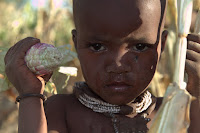The Himbas have protocol. If you want to visit, you must - more or less - follow a prescribed script. We kind of fudged it, but Weston, our wonderful guide, let us slide. I think it had something to do with our enthusiasm. We had bought bags of goodies to present to the chief, who basically sizes up your offering to determine if you are worthy of visiting his village. You must get permission from the Chief before you're allowed in, no exceptions.
We were told to buy food that Himba's eat: mealie meal (cornmeal), sugar, oil and coffee. Well, I bought peanuts, raisins, a scrub brush, bread, lentils, coffee and tea, matches, oil, rice, salt and pepper. The pepper was tossed out by our guide before I even stepped foot on Himba soil. He was very reluctant to present our goodies to the chief; apparently our coffee was too expensive, there were too many American type foods and the mealie meal was not quite right...I think he said it was too small a bag (or too big, we weren't quite sure) and too expensive a brand. I figured that if we are presenting this to the Chief for his blessing, I better get the good stuff.
We rolled up to this beautiful little village 20k from town. Weston jumped out of the car and headed for the Chief's house. From where Glenn and I sat, there seemed to be a bit of negotiation between Weston and the Chief.
We're in. Once you get the Chief's permission, you have carte blanche to roam the village. You are even allowed to pass through the sacred fire pit.
First, I must describe the Chief. He is old, but doesn't know how old. he has 6 wives and between 26-30 children. His father before him was also a chief; succession goes to the first born boy of the first wife (who is your first cousin). This particular Chief is a hero, a hunter who had killed many lions with his own blade. Weston drew our attention to the enormous bite scars on his leg. When asked how many people live in his village, he held his arms out and gestured across the horizon saying many...can't you see? Just look at all of these huts. Weston had already prepared us for such an answer, counting isn't part of their world.
We spent a half an hour or so with Chief before touring the village. Most of the ladies were out in the garden harvesting the corn, so we headed down the road to find them. We entered the garden through a pretty seriously fortified thorn bush fence and a gate stained red with Ochre. The ladies were busily harvesting the corn, babies were lost among the stalks and a bevy of children ran over to get a look at us. They really are just as curious about us as we are of them.
Glenn and I were gathered around a woman who sat shucking corn. Glenn happened to be standing in the path of the incoming buckets and quickly learned that the garden is not a place to stand around gawking. he was quickly put to work.
We returned to the village and thanked the Chief for welcoming us. We had such a wonderful day. He asked us questions about where we came from, how many children/cattle/goats we had and couldn't believe that we had none. I did boast about growing our own food and having chickens, but I don't think he was impressed. he asked Glenn if he had to cook his own food, or if I cooked for him.When Glenn said I was the cook, he asked if I cooked over a fire or with a machine. G told him that I could cook anywhere. We may have gained a tiny respect for that one.
As we were leaving we presented our gifts. In addition to the food, we had brought a soccer ball for the kids. I gave him some 'American' food, which he stashed for himself, and an orange. Chiefs like oranges. The rest of the goods we placed on the ground by his kitchen and said coudinowa (Bye bye in Himba) and headed back to town.
Wow. What a delight. GP and I had a wonderful time. Of course, it wouldn't have been possible if it wasn't for our friend Weston. A Himba who ran away from his village as a very young boy because he wanted to know how it felt to ride in a car. He would watch the Herero children pass by their village and knew that in order to ride in a car, he needed an education. One day as he was shepherding his families goats, he made a break for it. Leaving the goats and his family behind he walked 2 days to reach Opuwo where a Herero family took him in. He put himself through primary school, secondary school and eventually attending college in Zimbabwe. He was remarkable to be with. He knew the Himbas because he is Himba.
Thank you Weston. We loved every minute of our time together. And Glenn has no idea how you kept your white shoes so clean out there.
G+C
If you're interested in seeing the rest of our photos you can check out our Picasa web album at, http://picasaweb.google.com/Corrincphillips/Himba#













































